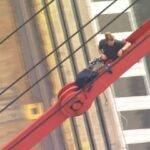The Offence of Climbing on or Jumping From a Building in New South Wales

Do you ever see people in the city jumping off ledges, climbing up buildings and running along rails? You’ve likely witnessed the sport of parkour, an athletic discipline that’s been increasing in popularity.
The following outlines the origins and characteristics of the sport and covers a few areas of the criminal law parkour participants may find themselves on the wrong side of.
What Is Parkour?
The goal of parkour is to navigate the urban environment and to attempt from from point A to point B in the fastest and most efficient way possible.
Parkour has its roots in military obstacle courses and certain martial arts. In order to traverse the urban landcare, parkour practitioners (known as traceurs) will climb structures, jump across chasms and vault over barriers, with a lot of flipping and rolling for show.
The Australian Parkour Association is the peak body representing the sport nationally.
Whilst most forms of parkour are perfectly legal, there are some variation of the sport which could get people in trouble with the law.
The Offence of Climbing / Jumping Off Buildings
If parkour participants are scaling and navigating buildings dangerously and without the permission of the property owner, they run the risk of being charged with an offence.
Section 8A of the Summary Offences Act 1988 (NSW) makes it an offence for a person to risk the safety of any other person as a consequence of:
- Abseiling, jumping or parachuting from any part of a building or other structure, or
- Climbing down or up or on or otherwise descending (except as referred to in paragraph (a)) or ascending any part of a building or other structure, except by use of the stairs, lifts or other means provided for ascent or descent of it.
A ‘structure’ includes a bridge, crane (whether mobile or not) and tower, but does not include a structure provided for climbing or jumping for recreational purposes.
This offence carries a maximum penalty of 3 months imprisonment and/or a fine of $1,100.
The Offence of Unlawful Entry
If parkour is being done safely in a public place and not damaging property, it is generally a legal sport. However, hefty fines could apply when parkour participants start leaping over into private property.
Section 4 of the Inclosed Lands Protection Act 1901 (NSW) outlines the offence of unlawful entry into inclosed lands, where a person without lawful excuse:
- Enters into inclosed lands without the consent of the owner, occupier or person apparently in charge of those lands; or
- Remains on inclosed lands after being requested by the owner, occupier or person apparently in charge of those lands to leave those lands.
Inclosed lands is broadly defined, referring to:
Any land, either public or private, inclosed or surrounded by any fence, wall or other erection, or partly by a fence, wall or other erection and partly by a canal or by some natural feature such as a river or cliff by which its boundaries may be known or recognised, including the whole or part of any building or structure and any land occupied or used in connection with the whole or part of any building or structure.
It also includes certain ‘prescribed premises’ including:
- A government school or a registered non-government school within the meaning of the Education Act 1990;
- A child care service;
- A hospital; or
- A nursing home within the meaning of the Public Health Act 2010 .
The maximum penalty for this offence is:
- A fine of $1,100 for conduct which occurs in ‘prescribed premises’; and
- A fine of $550 in any other case.






